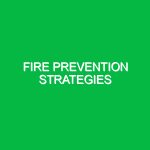In a world filled with uncertainties, one cannot overstate the importance of preparedness, especially in the realm of Health, Safety, and Environment (HSE). Among the various components of safety protocols, emergency exits and escape routes stand out as critical elements designed to safeguard lives during unforeseen circumstances. Whether it’s a fire, natural disaster, or another type of emergency, knowing the proper routes to safety can be the difference between life and death. This article delves into the various aspects of emergency exits and escape routes, their significance, associated risks, best practices, and relevant regulations, ensuring that you are well-equipped to handle emergencies effectively.
The Importance of Emergency Exits and Escape Routes in HSE
Emergency exits and escape routes are designated pathways and exits that lead individuals to safety during emergencies. Their relevance in HSE cannot be overstated. Imagine working in a high-rise building when suddenly the fire alarm blares. Panic ensues. In such scenarios, clearly marked and unobstructed emergency exits are vital for ensuring that everyone can evacuate quickly and safely. The layout of these exits can significantly reduce the risk of injury or fatality.
Furthermore, emergency exits and escape routes are not just a legal requirement; they are a moral obligation for employers and building managers. An effective emergency response plan, which includes these exits and routes, reassures employees and visitors that their safety is a priority. This sense of security can improve workplace morale and productivity, creating an environment where individuals can focus on their tasks rather than worry about potential hazards.
Potential Hazards and Risks Associated with Emergency Exits and Escape Routes
While emergency exits and escape routes are designed to promote safety, they can also present hazards if not properly maintained or planned. The following are some common risks associated with these critical pathways:
1. Obstruction and Blockage
One of the most significant hazards is obstruction. Emergency exits can be blocked by furniture, equipment, or even debris during an emergency. For instance, a case from a manufacturing plant highlighted how stacked boxes in front of an exit led to chaos during a fire evacuation. The blockage caused delays, leading to injuries and near-misses. Keeping pathways clear is essential for ensuring swift evacuations.
2. Poor Signage and Visibility
Another risk stems from inadequate signage. If exit signs are not clearly visible or illuminated, individuals may become confused or disoriented during a crisis. A study conducted on the evacuation of high-rise buildings indicated that 60% of participants experienced difficulty finding exits due to poor signage. This underscores the importance of well-placed, illuminated exit signs that guide individuals toward safety.
3. Complexity of Routes
Complex escape routes can lead to panic and confusion. In one notable incident at a crowded concert venue, the winding hallways caused many attendees to become trapped when an emergency occurred. Simple, straightforward escape routes are crucial for maintaining order during an evacuation.
4. Inadequate Training and Drills
Even the most well-marked and unobstructed exits are useless if individuals do not know how to use them. Regular drills and training sessions ensure that everyone is familiar with the escape routes. A fire safety expert once shared that many people forget the location of exits if they do not participate in frequent drills, highlighting the necessity of consistent training.
Best Practices for Emergency Exits and Escape Routes
To ensure the safety and effectiveness of emergency exits and escape routes, organizations should implement the following best practices:
1. Regular Inspections and Maintenance
Conducting regular inspections of emergency exits and escape routes is crucial. This includes checking for obstructions, ensuring that doors open easily, and verifying that exit signs are functional. Organizations should develop a maintenance schedule to address any issues promptly. A case study from a healthcare facility illustrated how routine checks helped identify and eliminate potential hazards, saving lives during a real emergency.
2. Clear Signage and Lighting
Proper signage is essential. Emergency exits should be marked with clear, illuminated signs that can be seen from various angles. Consider using glow-in-the-dark materials for signage that can remain visible even during power outages. Ensuring that escape routes are well-lit is also critical for preventing accidents during evacuations.
3. Straightforward Escape Routes
Design escape routes to be as direct and simple as possible. Avoid complicated paths that may confuse individuals during an emergency. Moreover, using visual aids, like floor plans, can help people familiarize themselves with the layout well in advance.
4. Conduct Regular Training and Drills
Regular training sessions and evacuation drills should be mandatory. Employees should understand the importance of emergency exits and practice using them. Following a successful drill, participants often feel more confident in their ability to evacuate safely, as evidenced by numerous studies in corporate environments.
5. Establish an Emergency Response Plan
An effective emergency response plan should include detailed procedures for both staff and visitors. This plan should outline how to communicate during an emergency, the roles of various individuals, and the specific actions to take. Having a robust plan not only enhances safety but also fosters a culture of preparedness within the organization.
Regulations and Standards Governing Emergency Exits and Escape Routes
Compliance with regulations and standards is essential for ensuring the safety of emergency exits and escape routes. Various codes and guidelines dictate how these exits should be designed and maintained. Here are some key regulations to consider:
1. Occupational Safety and Health Administration (OSHA) Standards
In the United States, OSHA provides guidelines on exit routes under the Occupational Safety and Health Act. Employers must ensure that exits are accessible and that employees are trained to use them effectively. OSHA mandates that exit doors must open outward and be free from obstructions.
2. National Fire Protection Association (NFPA) Codes
NFPA codes, particularly NFPA 101, provide comprehensive guidelines for life safety in buildings. These codes outline the requirements for emergency exits, including their number, placement, and maintenance. Compliance with NFPA standards is crucial for public safety.
3. International Building Code (IBC)
The IBC outlines the minimum requirements for building safety, including the design and construction of emergency exits. It specifies the dimensions, materials, and accessibility standards for these exits, ensuring that they can accommodate the expected number of occupants.
Conclusion: Prioritizing Safety Through Preparedness
Emergency exits and escape routes play an indispensable role in the realm of Health, Safety, and Environment. By understanding the potential hazards, implementing best practices, and complying with regulations, organizations can significantly improve their preparedness for emergencies. It is vital to foster a culture of safety where individuals are aware of their surroundings and equipped to act swiftly in a crisis. Remember, when it comes to safety, knowledge and preparation can pave the way for survival.


